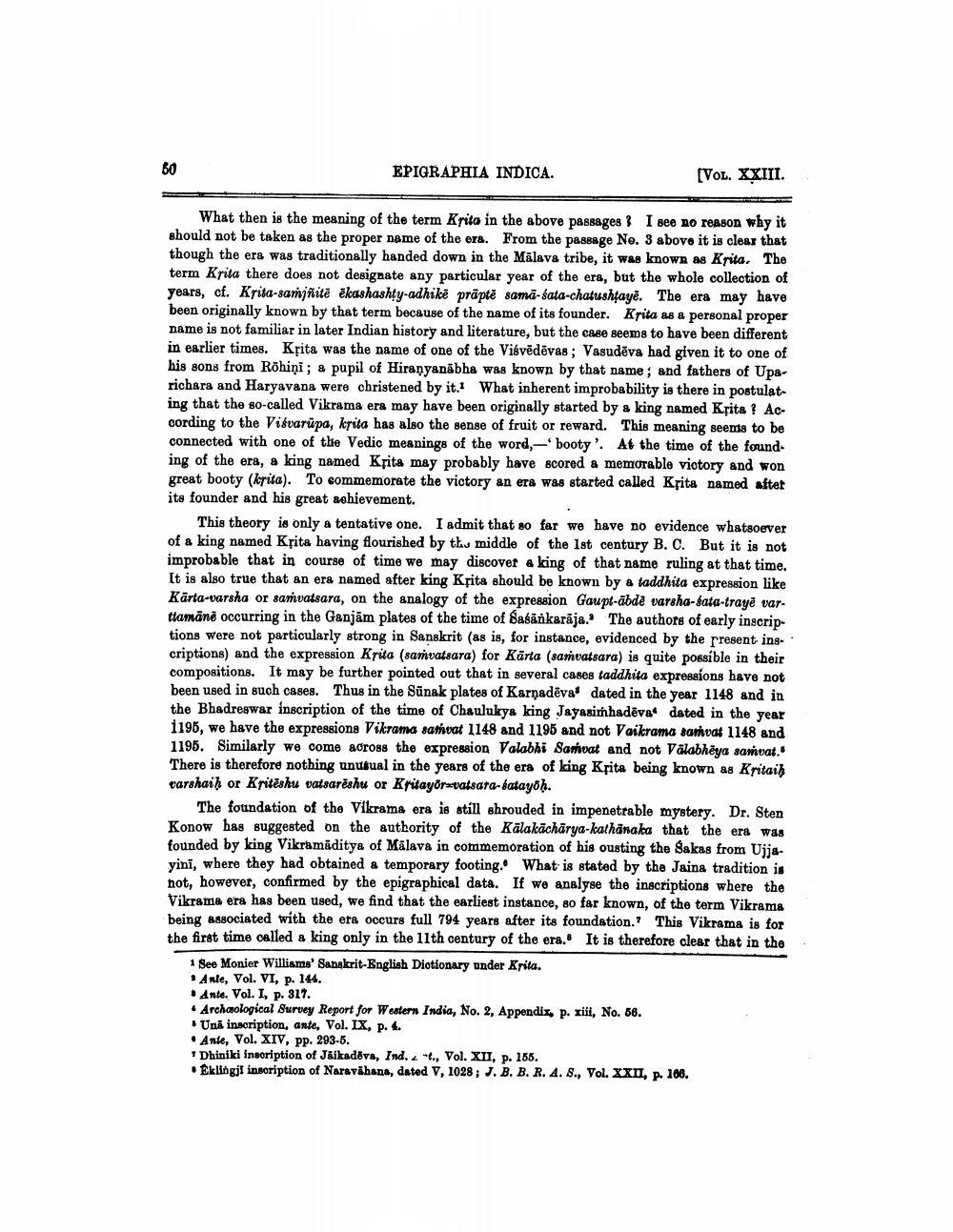________________
EPIGRAPHIA INDICA.
(VOL. XXIII.
What then is the meaning of the term Krito in the above passages ? I see no reason why it should not be taken as the proper name of the er&. From the passage No. 3 above it is clear that though the era was traditionally handed down in the Mālava tribe, it was known as Kpita. The term Krita there does not designate any particular year of the era, but the whole collection of years, cf. Krita-samjflite ekashashty-adhikė prāpte sama-sata-chatushtayė. The era may have been originally known by that term because of the name of its founder. Krita as a personal proper name is not familiar in later Indian history and literature, but the case seems to have been different in earlier times. Kpita was the name of one of the Visvēdēvas; Vasudeva had given it to one of his sons from Röhiņi; a pupil of Hiranyanābha was known by that name; and fathers of Uparichara and Haryavana were christened by it. What inherent improbability is there in postulating that the so-called Vikrama era may have been originally started by a king named Kțita ? According to the Visvarūpa, kita has also the sense of fruit or reward. This meaning seems to be connected with one of the Vedic meanings of the word, -booty'. At the time of the found ing of the era, a king named Krita may probably have scored a memorable viotory and won great booty (krita). To commemorate the victory an era was started called Krita named after its founder and his great achievement.
This theory is only a tentative one. I admit that so far we have no evidence whatsoever of a king named Kțita having flourished by ths middle of the 1st century B. C. But it is not improbable that in course of time we may discover a king of that name ruling at that time. It is also true that an era named after king Kțita should be known by a laddhita expression like Kārta-varsha or samvatsara, on the analogy of the expression Gaupt-ābde varsha-sata-traye varttamāné occurring in the Ganjām plates of the time of Sasankarāja. The authors of early inscriptions were not particularly strong in Sanskrit (as is, for instance, evidenced by the present ingcriptions) and the expression Kita (samvatsara) for Kārta (samvatsara) is quite possible in their compositions. It may be further pointed out that in several cases taddhita expressions have not been used in such cases. Thus in the Sūnak plates of Karnadeval dated in the year 1148 and in the Bhadreswar inscription of the time of Chaulukya king Jayasimhadēva dated in the year 1195, we have the expressions Vikrama samvat 1148 and 1195 and not Vaikrama sanhvat 1148 and 1195. Similarly we come across the expression Valabhi Santwat and not Valabhëya samvat. There is therefore nothing unusual in the years of the era of king Kpita being known as Kritaih varshaih or Kritēshu vatsarēshu or Kritayoravatsata-katayoh.
The foundation of the Vikrama era is still shrouded in impenetrable mystery. Dr. Sten Konow has suggested on the authority of the Kalakācharya-kathānala that the era was founded by king Vikramāditya of Mālava in commemoration of his ousting the Sakas from Ujjayini, where they had obtained a temporary footing. What is stated by the Jaina tradition is not, however, confirmed by the epigraphical data. If we analyse the inscriptions where the Vikrama era has been used, we find that the earliest instance, so far known, of the term Vikrama being associated with the era occurs full 794 years after its foundation. This Vikrama is for the first time called a king only in the 11th century of the era. It is therefore clear that in the
1 See Monier Williams' Sanskrit-English Dictionary under Krita. * Anle, Vol. VI, p. 144. • Ante. Vol. I, p. 317. • Archæological Survey Report for Western India, No. 2, Appendix, p. xiii, No. 66. . Una inscription, ante, Vol. IX, p. 4. • Ante, Vol. XIV, pp. 293-5. 1 Dhiniki insoription of Jāikadēva, Ind. t., Vol. XII, p. 165. • Eklingji insoription of Naravāhana, dated V, 1028; J. B. B. R. A. 8., Vol. XXII, p. 166.




